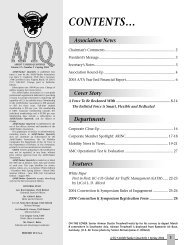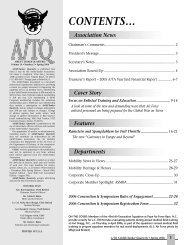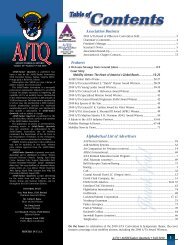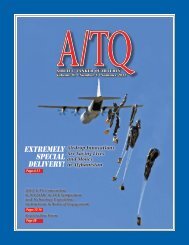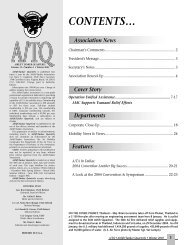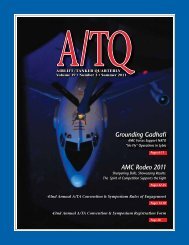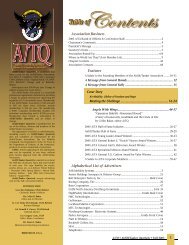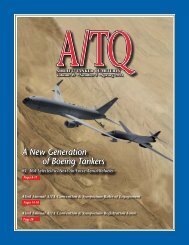1) ATQ Fall 2003 for pdf - Airlift/Tanker Association
1) ATQ Fall 2003 for pdf - Airlift/Tanker Association
1) ATQ Fall 2003 for pdf - Airlift/Tanker Association
You also want an ePaper? Increase the reach of your titles
YUMPU automatically turns print PDFs into web optimized ePapers that Google loves.
conflict, it has provided life-sustaining care transporting thousands of<br />
patients and their families around the globe, and I feel <strong>for</strong>tunate that<br />
I’ve been able to be a part of its history.”<br />
Capt. Russel Frantz, medical crew director <strong>for</strong> the 375 AES,<br />
elaborated on the final mission.<br />
“The next time you’ll see this aircraft will probably be in a museum.<br />
This has been the<br />
most rewarding<br />
job. It was the first<br />
plane I qualified<br />
on and it is truly<br />
the ‘Cadillac of air<br />
evac’ I’m going to<br />
miss it.”<br />
Standing on the tarmac at Ramstein Air Base,<br />
Germany, Airman 1st Class Gentry Koepp salutes<br />
the last C-9 Nightingale aeromedical evacuation<br />
from Ramstein on 27 September. Koepp is a crew<br />
chief assigned to the 86th Aircraft Maintenance<br />
Squadron. The 75th <strong>Airlift</strong> Squadron crew flew the<br />
C-9A to Scott Air Force Base, Illinois, where it will<br />
be transferred to the Air Force Reserve. (U.S. Air<br />
Force photo by Master Sgt. Jon Hanson)<br />
Senior Master<br />
Sgt. Sam Dalton,<br />
medical technician<br />
<strong>for</strong> the 932 AES,<br />
has been doing<br />
AE <strong>for</strong> 28 years<br />
and says he’ll not<br />
only miss the C-9,<br />
but its role in AE<br />
missions.<br />
“The most<br />
rewarding part<br />
of this job was<br />
carrying patients to<br />
safety, providing the medical care they needed on an airframe like the<br />
C-9. What I’ll miss most is the personal interaction with the patients.<br />
It’s unlike any other job in the world.”<br />
Colonel Lang<strong>for</strong>d concluded, “The C-9 mission has been a total <strong>for</strong>ce<br />
ef<strong>for</strong>t from the beginning with crews consisting of active duty, Air Force<br />
Reserve Command, and on occasion, Air National Guard crews.”<br />
Crewmembers fold the American flag flown aboard<br />
a C-17 Globemaster III during the first Tri-Wall Aerial<br />
Delivery System mission over Afghanistan. The crew<br />
delivered humanitarian daily rations to Afghanistan.<br />
C-17s carried thousands of rations packed in TRIAD<br />
boxes. (U.S. Air Force photo)<br />
C-17 Globemaster III<br />
Team Altus Moves Stryker<br />
by TSgt. Robert Burgess<br />
97 th AMW PA<br />
With little time and a lot of ef<strong>for</strong>t, the 97th Air Mobility Wing<br />
completed a joint Air Force and U.S. Army three-day field training<br />
exercise May 2 - 4, a full 13 hours ahead of schedule.<br />
The 97th Operations Group was tasked to shuttle the Army’s new<br />
armor personnel carrier “Stryker,” from Fort Sill Okla., located 60<br />
miles from Altus AFB to Alexandria, La.<br />
“We had 48 hours to plan <strong>for</strong> and launch the first mission,<br />
normally it takes about 30 days to plan <strong>for</strong> a mission like this,” said Lt.<br />
Col. Gene Carter, 58th <strong>Airlift</strong> Squadron commander and the deployed<br />
commander at Alexandria.<br />
Notification came from the U.S. Transportation Command through<br />
Air Education and Training Command, Randolph AFB, Texas, the<br />
MAJCOM headquarters <strong>for</strong> our wing, said Colonel Carter.<br />
“The U.S. Transportation Command normally doesn’t request<br />
aircraft from a training command, but with the high level of support<br />
to CENTCOM and the importance of this exercise to the Army, we<br />
needed help,” said Air Force Col. Curtis Ross, deputy director of<br />
operations at USTRANSCOM.<br />
As the third C-17 sortie landed at Alexandria and offloaded the<br />
Stryker and support equipment, Colonel Carter said, “This airlift<br />
portion of the exercise is only one phase of the Army’s certification<br />
process to validate the Stryker’s Combat readiness as part of a<br />
congressionally directed evaluation.”<br />
In simulating a real world deployment of the Army’s 3rd Brigade,<br />
2nd Infantry Division (Stryker Brigade Combat Team), Fort Lewis,<br />
Wash., the 58th<br />
AS averaged one<br />
takeoff and landing<br />
per hour using<br />
engine running<br />
offload procedures<br />
at Alexandria<br />
to download 55<br />
Strykers, 140 pieces<br />
of support vehicles<br />
and 667 passengers.<br />
The drill started<br />
at 1 p.m., May<br />
1 with the first<br />
C-17 launching<br />
from here, headed<br />
<strong>for</strong> Fort Sill and<br />
another at 3 p.m.,<br />
said TSgt. Scott<br />
Haak, 58th AS<br />
A Stryker personnel carrier is unloaded in<br />
Alexandria, Louisiana, from a C-17 Globemaster<br />
III from Altus Air Force Base, Oklahoma, during a<br />
joint service exercise mission involving members of<br />
the 97th Air Mobility Wing and the Army’s Stryker<br />
Brigade Combat Team. (U.S. Air Force photo by<br />
Airman Richard W. Rose Jr.)<br />
loadmaster instructor and flight scheduler <strong>for</strong> the 97th Operations<br />
Support Squadron. “The two aircraft were used to review the onloading<br />
procedures of the Stryker and to preposition loaded aircraft.”<br />
Five C-17s and 11 aircrews flew 45 shuttles totaling 90 sorties<br />
and completed the exercise in 46 hours. “To ensure success, a sixth<br />
aircraft was flown to Fort Sill to act as a spare aircraft and another was<br />
standing by at Altus AFB,” said Lt.Col. Mike Gosnell, 58th AS director<br />
of operations and Fort Sill mission commander.<br />
Twelve hours after the first aircraft touched down at Alexandria<br />
International Airport, <strong>for</strong>merly know as England AFB, Colonel<br />
Gosnell said, “We’ve already moved a million and half pounds in less<br />
than a day.”<br />
Fort Sill’s rather short 5000-foot runway did not hinder C-17<br />
operations as the aircraft moved maximum cargo loads. “Because<br />
of the short distances we’re flying, we’re able to refuel aircraft with<br />
enough fuel to land at an alternate location in case of bad weather<br />
or an emergency. We’re turning jets in about an hour and half,” said<br />
Colonel Gosnell.<br />
Shortly be<strong>for</strong>e midnight on May 1, Lt. Col. Carter landed Reach 218<br />
at Fort Sill from Altus AFB to fly the first sortie carrying three Strykers<br />
and 23 passengers to Alexandria, La.<br />
Loadmaster TSgt. William Wittenbrink said, “Two duty loadmasters<br />
pre-loaded the Stryker and verified the loading procedures using the<br />
Boeing loading certification letter.”<br />
The load weighs 113,000 pounds compared to average training load<br />
A/TQ •<strong>Airlift</strong>/<strong>Tanker</strong> Quarterly • <strong>Fall</strong> <strong>2003</strong><br />
21




